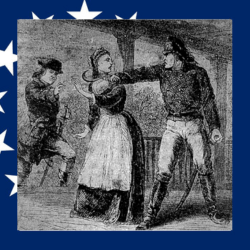
For Martha Bratton, the Revolutionary War started with a bang. In a whirlwind of events, she ended up blowing up her home, and allegedly, British troops went with it. How did she end up in such a scenario in the first place? To answer that question, we have to look back to her origins and recount her fabled sense of devotion and bravery.
Born a North Carolinian in 1750 in what is now Rowan County, it can be assumed that Martha had a relatively well-to-do upbringing. Little is known about the exact details of her early life, but her marriage to William Bratton sometime around 1770 indicates that her family had some wealth or status; marriages during this time were heavily influenced by social standing, and often indicative of a couple’s social standing.
Martha and William settled in South Carolina, but soon after their marriage, the colony descended into chaos. As part of their efforts to combat the American Declaration of Independence, the British sought to take over the state and secure the cities within it under the Crown’s rule. In 1780, as British troops advanced throughout the region they began punishing by death anyone who defied their rule.
Charleston fell in May of that year, but until then all patriots in the region did their best to hold out and continue to fight for their independence. Martha and her household were no different. British troops throttled the importation of goods into the region, making it difficult to acquire any ammunition, but her household held secret stores of it. Unfortunately, word got out of this hidden stash, and British troops came to collect the gunpowder.
Martha was not given sufficient warning about the troop’s arrival and was forced to act fast. Knowing she did not have enough time to move it to an alternative location, she instead made a trail of gunpowder leading safely away from her home and simply waited for the British to come. Once they were in sight, she ignited the trail and blew up the troops. If the Revolutionary troops could not use the gunpower to fight their enemies, she would.
Later that year, William, a Colonel in the Continental Army, could not go undetected. On an evening in June 1780, British troops arrived at Martha’s doorstep, demanding to know the whereabouts of her husband. After her initial refusal, Martha found herself with a sharpened hook to her neck. Devoted to her husband and her country, she told the troops that she did not know the location of her husband, and insisted that they be on their way.
Martha survived that encounter with militant Britains, illustrating a second incidence of her incredible bravery. The actions she took to preserve the integrity of the Revolutionary movement are truly remarkable, and the bravery she displayed is something that many individuals can only dream of.
Following independence, Martha and her family settled their land once more. Returning to a quaint way of life, the couple and their children became local legends for their heroic acts, and a school for girls was opened in Brattonsville, the town’s name also named after the family, paying homage to their bravery. In the year 1817, William Bratton passed away, with Martha following just one year after; her cause of death is unknown.
